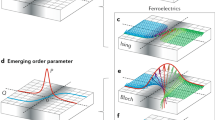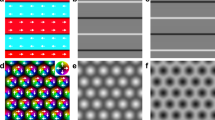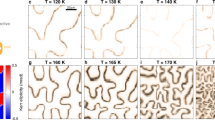Abstract
Domain walls naturally arise whenever a symmetry is spontaneously broken. They interconnect regions with different realizations of the broken symmetry, promoting structure formation from cosmological length scales to the atomic level1,2. In ferroelectric and ferromagnetic materials, domain walls with unique functionalities emerge, holding great promise for nanoelectronics and spintronics applications3,4,5. These walls are usually of Ising, Bloch or Néel type and separate homogeneously ordered domains. Here we demonstrate that a wide variety of new domain walls occurs in the presence of spatially modulated domain states. Using magnetic force microscopy and micromagnetic simulations, we show three fundamental classes of domain walls to arise in the near-room-temperature helimagnet iron germanium. In contrast to conventional ferroics, the domain walls exhibit a well-defined inner structure, which—analogous to cholesteric liquid crystals—consists of topological disclination and dislocation defects. Similar to the magnetic skyrmions that form in the same material6,7, the domain walls can carry a finite topological charge, permitting an efficient coupling to spin currents and contributions to a topological Hall effect. Our study establishes a new family of magnetic nano-objects with non-trivial topology, opening the door to innovative device concepts based on helimagnetic domain walls.
This is a preview of subscription content, access via your institution
Access options
Access Nature and 54 other Nature Portfolio journals
Get Nature+, our best-value online-access subscription
$29.99 / 30 days
cancel any time
Subscribe to this journal
Receive 12 print issues and online access
$209.00 per year
only $17.42 per issue
Buy this article
- Purchase on Springer Link
- Instant access to full article PDF
Prices may be subject to local taxes which are calculated during checkout




Similar content being viewed by others
References
Chuang, I., Durrer, R., Turok, N. & Yurke, B. Cosmology in the laboratory: defect dynamics in liquid crystals. Science 251, 1336–1342 (1991).
del Campo, A. & Zurek, W. H. Universality of phase transition dynamics: topological defects from symmetry breaking. Inter. J. Mod. Phys. A 29, 1430018 (2014).
Catalan, G., Seidel, J., Ramesh, R. & Scott, J. F. Domain wall nanoelectronics. Rev. Mod. Phys. 84, 119–156 (2012).
Parkin, S. S. P., Hayashi, M. & Thomas, L. Magnetic domain-wall racetrack memory. Science 320, 190–194 (2012).
Salje, E. & Zhang, H. Domain boundary engineering. Phase Transit. 82, 452–469 (2009).
Yu, X. Z. et al. Real-space observation of a two-dimensional skyrmion crystal. Nature 465, 901–904 (2010).
Yu, X. Z. et al. Near room-temperature formation of a skyrmion crystal in thin-films of the helimagnet FeGe. Nat. Mater 10, 106–109 2011).
Bak, P. & Jensen, M. H. Theory of helical magnetic structures and phase transitions in MnSi and FeGe. J. Phys. C 13, L881–L885 (1980).
de Gennes, P. G. & Prost, J. The Physics of Liquid Crystals. (Clarendon: Oxford, 1993.
Hubert, A. & Schäfer, R. Magnetic Domains: The Analysis of Magnetic Microstructures. (Springer: Berlin, Heidelberg, 2009.
Kléman, M. Magnetic singularities in helimagnet crystals. Philos. Mag. 22, 739–749 (1970). 178.
Seul, M., Monar, L. R., O’Gorman, L. & Wolfe, R. Morphology and local structure in labyrinthine stripe domain phase. Science 254, 1616–1618 (1991).
Uchida, M. et al. Topological spin textures in the helimagnet FeGe. Phys. Rev. B 77, 184402 (2008).
Li, F., Nattermann, T. & Pokrovsky, V. L. Vortex domain walls in helical magnets. Phys. Rev. Lett. 108, 107203 (2012).
Lebech, B., Bernhard, J. & Freltoft, T. Magnetic structures of cubic FeGe studied by small-angle neutron scattering. J. Phys. Condens. Matter 1, 6105 (1989).
Rybakov, F. N., Borisov, A. B., Blügel, S. & Kiselev, N. S. New spiral state and skyrmion lattice in 3D model of chiral magnets. New J. Phys. 18, 045002 (2016).
Yagil, A. et al. Stray field signatures of Néel textured skyrmions in Ir/Fe/Co/Pt multilayer films. Preprint at https://arxiv.org/abs/1705.07608 (2017).
Bouligand, Y. in Dislocations in Solids (ed. Nabarro, F. R. N.) Ch. 23 (North-Holland Publishing Company, New York, NY, 1983).
Bouligand, Y. Recherches sur les textures des états mésomorphes. 3. Les plages à éventails dans les cholestériques. J. Phys. Fr. 34, 603–614 (1973).
Bouligand, Y. Recherches sur les textures des états mésomorphes. 4. La texture à plans et la morphogenèse des principales textures dans les cholestériques. J. Phys. Fr. 34, 1011–1020 (1973).
Nagaosa, N. & Tokura, Y. Topological properties and dynamics of magnetic skyrmions. Nat. Nanotech. 8, 899–911 (2013).
Garst, M. in Topological Structures in Ferroic Materials (ed. Seidel, J.) Ch. 2 (Springer, Berlin, Heidelberg, 2016).
Neubauer, A. et al. Topological Hall effect in the A phase of MnSi. Phys. Rev. Lett. 102, 186602 (2009).
Schulz, T. et al. Emergent electrodynamics of skyrmions in a chiral magnet. Nat. Phys. 8, 301–304 (2012).
Schütte, C. & Garst, M. Magnon-skyrmion scattering in chiral magnets. Phys. Rev. B 90, 094423 (2014).
Mochizuki, M. et al. Thermally driven ratchet motion of a skyrmion microcrystal and topological magnon Hall effect. Nat. Mater 13, 241–246 (2014).
Bauer, A. et al. Symmetry breaking, slow relaxation dynamics, and topological defects at the field-induced helix reorientation in MnSi. Phys. Rev. B 95, 024429 (2017).
Dussaux, A. et al. Local dynamics of topological magnetic defects in the itinerant helimagnet FeGe. Nat. Commun. 7, 12430 (2016).
Janoschek, M. et al. Fluctuation-induced first-order phase transition in Dzyaloshinskii–Moriya helimagnets. Phys. Rev. B 87, 134407 (2013).
Wilhelm, H. et al. Precursor phenomena at the magnetic ordering of the cubic helimagnet FeGe. Phys. Rev. Lett. 107, 127203 (2011).
Pfleiderer, C., Julian, S. R. & Lonzarich, G. G. Non-Fermi-liquid nature of the normal state of itinerant-electron ferromagnets. Nature 414, 427–430 (2001).
Ritz, R. et al. Formation of a topological non-Fermi liquid in MnSi. Nature 497, 231–234 (2013).
Pedrazzini, P. et al. Metallic state in cubic FeGe beyond its quantum phase transition. Phys. Rev. Lett. 98, 047204 (2007).
Fert, A., Cros, V. & Sampaio, J. Skyrmions on the track. Nat. Nanotech. 8, 152–156 (2013).
Wiesendanger, R. Nanoscale magnetic skyrmions in metallic films and multilayers: a new twist for spintronics. Nat. Rev. Mater. 1, 16044 (2016).
Acknowledgements
We thank M. Fiebig for direct financial support. The work at ETH was supported by the Swiss National Science Foundation through grants 200021-149192 and 200021-137520. L.K. and M.G. were supported by SFB 1143 'Correlated Magnetism: From Frustration To Topology' and DFG grant GA 1072/5-1. J.M. and A.R. were supported by SFB 1238 (Kontrolle und Dynamik von Quantenmaterialien). J.M. also acknowledges support from the Deutsche Telekom Stiftung and Bonn-Cologne Graduate School of Physics and Astronomy BCGS. N.K. acknowledges funding through the JSPS Grant-in-Aids for Scientific Research (S) no. 24224009 and for Young Scientists (Start-up) no. 26886005. D.M. thanks the Research Council of Norway (FRINATEK project no. 263228) and the Norwegian University of Science and Technology (NTNU) for financial support.
Author information
Authors and Affiliations
Contributions
P.S. conducted the MFM experiments supervised by D.M.; J.M. performed the two-dimensional micromagnetic simulations supervised by M.G. and A.R.; N.K. grew the FeGe single crystals under supervision of Y.T.; P.S., J.M., L.K., M.G. and D.M. classified the domain walls; M.G. and L.K. defined the skyrmion charge of edge dislocations; P.S., J.M., L.K., M.G. and D.M. wrote the paper; M.G. and D.M. supervised the work. All authors discussed the results and contributed to their interpretation.
Corresponding authors
Ethics declarations
Competing interests
The authors declare no competing interests.
Additional information
Publisher’s note: Springer Nature remains neutral with regard to jurisdictional claims in published maps and institutional affiliations.
Supplementary information
Supplementary Materials
Supplementary Text, Supplementary References 36–40, Supplementary Figures S0–S17
Rights and permissions
About this article
Cite this article
Schoenherr, P., Müller, J., Köhler, L. et al. Topological domain walls in helimagnets. Nature Phys 14, 465–468 (2018). https://doi.org/10.1038/s41567-018-0056-5
Received:
Accepted:
Published:
Issue Date:
DOI: https://doi.org/10.1038/s41567-018-0056-5
This article is cited by
-
Experimental observation of current-driven antiskyrmion sliding in stripe domains
Nature Materials (2024)
-
Energy Scaling Law for a Singularly Perturbed Four-Gradient Problem in Helimagnetism
Journal of Nonlinear Science (2023)
-
Interfacial phase frustration stabilizes unconventional skyrmion crystals
npj Quantum Materials (2022)
-
Variational Analysis of the \(J_1\)–\(J_2\)–\(J_3\) Model: A Non-linear Lattice Version of the Aviles–Giga Functional
Archive for Rational Mechanics and Analysis (2022)
-
Stripe skyrmions and skyrmion crystals
Communications Physics (2021)



